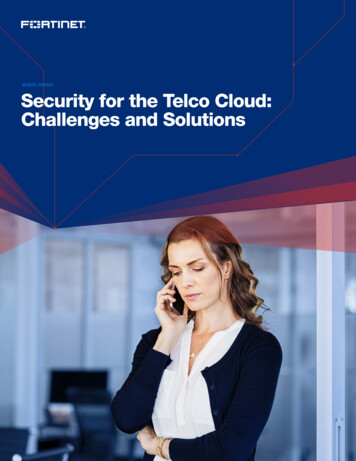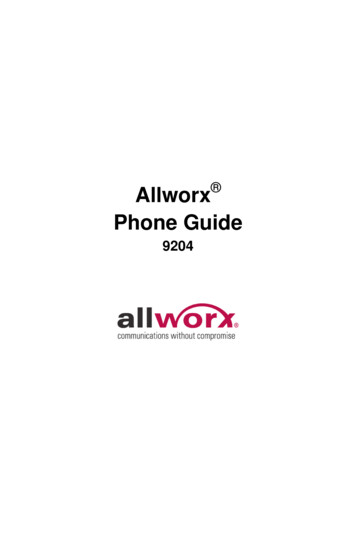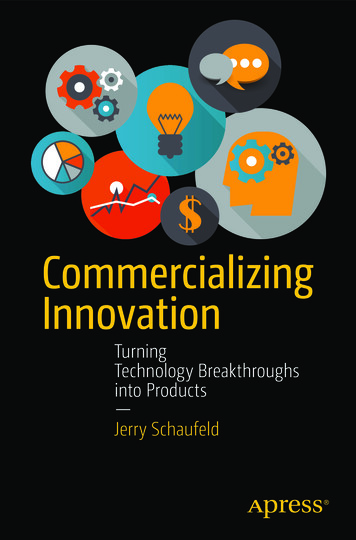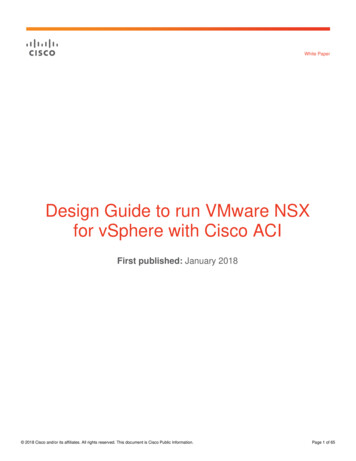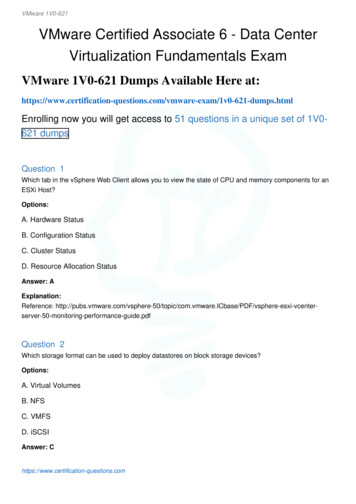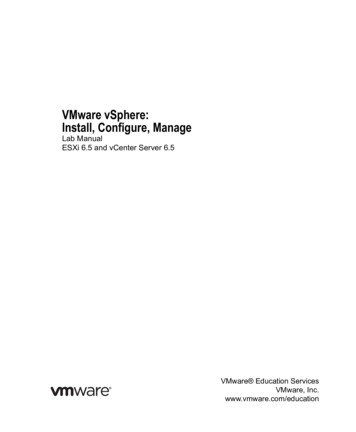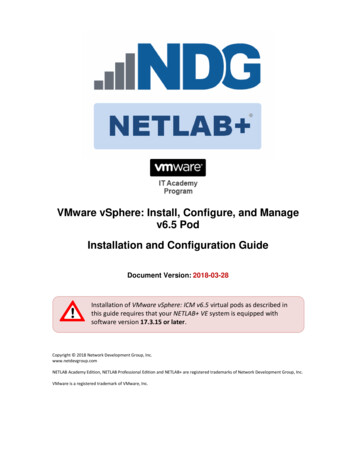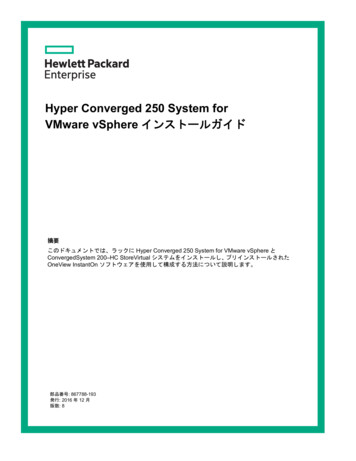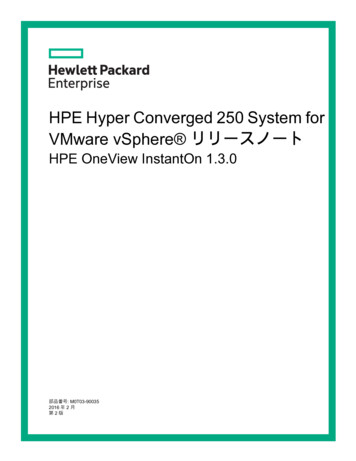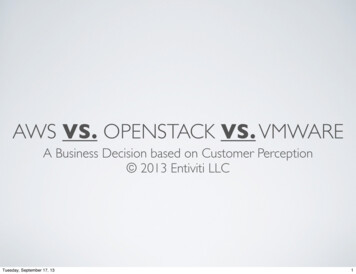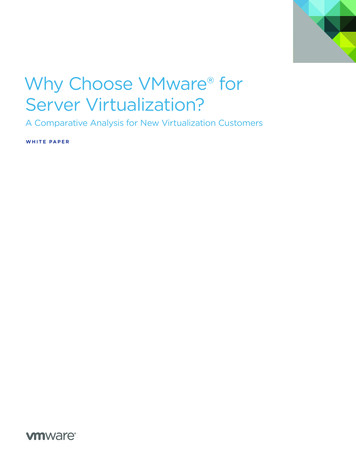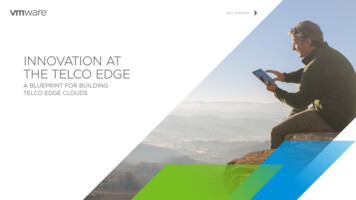
Transcription
GE T S TARTEDINNOVATION ATTHE TELCO EDGEA BLUEPRINT FOR BUILDINGTELCO EDGE CLOUDS
Defining theTelco EdgeEdge Cloud: ABusiness ImperativeDriving Revenue andValue at the EdgeA Path to DeployingTelco Edge Clouds6 Steps to EdgeCloud ReadinessDefining the Telco EdgeNew technologies, new business models, new competition—the world of communications service providers (CSPs) is evolvingmuch faster than anyone imagined. With massive growth in bandwidth demand and device proliferation, CSPs are buildingdeeper and closer to edge of the network in order to meet the bandwidth needs and low-latency requirement for deliveringhigh quality user experiences. Meanwhile, 5G also brings the promise of delivering 10x faster broadband and mobility servicesthat are ultra-reliable and low-latency, creating new use cases and revenue opportunities. CSPs are racing to compete withthe same customer set, both residential and enterprise customers, with faster and better services.Resources for YourEdge Cloud JourneyAT A GLANCEVMware takes a policy-driven approach todeliver a telco edge architecture that enablesoperators to develop an end-to-end architectureto service applications across core and edgeclouds. The platform is optimized to deliverenhanced telco services using both traditionaland microservices-based applications and extendthe operator network to third-party applications.Network virtualization and cloud technologies are no longer new to CSPs, especially at the core datacenter. CSPs can applythe same principle and operational processes to extend the core network to the edge for expanding their network.Edge computing also drives more innovations for ultra-low latency and high-performance applications and services. Edgecomputing is necessary for emerging applications, such as autonomous/robotic operations, AI and ML real time analyticsand intelligent insights, video processing, live/drone surveillance, object/gesture recognition, location/geo-spatial servicesand AR/VR gaming and learning—wherever data is being generated, processed, and consumed at the edge.However, it is not a simple task for CSPs to be able to deploy these new services quickly, securely, and at scale at the edge ofthe network. Deploying and operating such a distributed cloud environment is complex and requires significant enhancementsin the cloud architecture, networking approach, and operations management. This requires cloud-first architecture and astrategy to plan, design, and build an agile, scalable, manageable, and secure platform in order to cost-effectively extendtheir reach, grow revenue and market share, and meet their business objectives at the telco edge.This paper looks at these complex requirements, and discusses how CSPs can combine the computingpower of the cloud with intelligence at the edge of their networks to create a framework for buildingimpactful user experiences.INNOVATION AT THE TELCO EDGE2
Defining theTelco EdgeEdge Cloud: ABusiness ImperativeDriving Revenue andValue at the EdgeA Path to DeployingTelco Edge Clouds6 Steps to EdgeCloud ReadinessResources for YourEdge Cloud JourneyEdge Cloud: A Business ImperativeCSPs have several different priorities in their network transformation efforts. Some are modernizing their existing architectureand infrastructure as they evolve toward modern, cloud-first principles, while others are innovating with business models andapplications. Whatever the intent and business use case, they all share the objectives of greater responsiveness andreadiness for the needs of their business.The objectives for edge clouds can be categorized broadly under the following business challenges:DRIVE BUSINESS AGILITY AND INNOVATIONCombining agile infrastructure with edge clouds can accelerate business innovation. An agile development platform requiresCSPs to collaborate with vendors on differentiated offerings and rapidly add subscriber features and functionality in responseto market opportunities. An agile edge computing infrastructure enables rapid scaling that benefits clustered multi-user gamesor experiences that share context, such as player location and orientation among players located close to one another. Anotherexample is personalized applications enabled by local context. CSPs are also looking at alternative business models such asproviding a PaaS platform for third-party applications. A modern infrastructure is key to such opportunities, as they requirethe creation of developer-centric edge ecosystems that let developers tap into telco edge APIs—and the algorithm economyto help them create innovative and disruptive edge applications.INNOVATION AT THE TELCO EDGE3
Defining theTelco EdgeEdge Cloud: ABusiness ImperativeDriving Revenue andValue at the EdgeA Path to DeployingTelco Edge Clouds6 Steps to EdgeCloud ReadinessResources for YourEdge Cloud JourneyMODERNIZE MULTI-CLOUD NETWORK OPERATIONSThere is an acute focus on increasing the speed of change and improving operational resilience. An integrated operationalintelligence framework provides advanced service lifecycle capabilities, monitoring and resilience, and improved operationalefficiency by providing an integrated view of infrastructure, services, and applications. Similarly, efficient workload placementrequires real-time load and available capacity along with collaboration between CSPs and software ecosystem partners, mainlyVirtual Network Function (VNF) and Containerized Network Function (CNF) vendors. A prescriptive set of steps must be followedto package and deploy VNF/CNF, with the VNF/CNF vendor providing the prerequisites for successful VNF/CNF onboarding.This includes the VNF/CNF format, east–west and north–south connectivity, routing and security policy, and performancerequirements. This also requires fine-grained resource allocation and control where consistent resource allocation at the edgeand core data center ensures that tenant resources are provisioned and made available as and when required by the business.Drive BusinessAgility and InnovationModernize Multi-CloudNetwork OperationsEnsure ApplicationPerformance andSecurityAccelerate ApplicationDevelopment andDeliveryFIGURE 1: Top Business Challenges Faced by Communications Service ProvidersINNOVATION AT THE TELCO EDGE4
Defining theTelco EdgeEdge Cloud: ABusiness ImperativeDriving Revenue andValue at the EdgeA Path to DeployingTelco Edge Clouds6 Steps to EdgeCloud ReadinessResources for YourEdge Cloud JourneyENSURE APPLICATION PERFORMANCE AND SECURITYUse of hardware accelerators and DPDK-based workload acceleration greatly enhances application performance and createsdifferentiated customer experiences. Edge computing, however, also greatly expands the number of potential access pointsacross the network, and CSPs need tools to provide higher levels of protection. This requires the use of secure cloud gateways,micro-segmentation, and an ecosystem of VNF and CNF solutions for networking and security across workloads and tenantswitching and routing fabric. Another aspect that impacts overall security and performance is the necessity to provide resourceisolation and resource guarantees across applications. This requires a secure multi-tenant environment with dynamic resourceallocation. Finally, robust business continuity requires edge cloud components to implement high availability by default whileallowing applications to leverage platform capabilities and extend their availability.ACCELERATE APPLICATION DEVELOPMENT AND DELIVERYIncreased speed of application delivery has become a fundamental business imperative. The industry is coalescing aroundthe use of containers as a unifying platform across development, operations, security, QA, and other teams. With a DevOpsapproach, teams are embracing CI/CD practices and container-based automation to accelerate the app delivery cycle. CSPscan no longer just build edge cloud infrastructure and hope for adoption—they must actively promote software innovationwith applications optimized for a decentralized cloud ecosystem. By providing application developers with the tools neededto tap into the distributed edge infrastructure, CSPs can promote innovative solutions that offer enhanced customerexperience and better service. Edge solutions, discussed later in this document, are a critical part of this effort.INNOVATION AT THE TELCO EDGE5
Defining theTelco EdgeEdge Cloud: ABusiness ImperativeDriving Revenue andValue at the EdgeA Path to DeployingTelco Edge Clouds6 Steps to EdgeCloud ReadinessDriving Revenue and Value at the EdgeCSPs are in prime position to offer their customers the required telco infrastructure that matches the requirements ofapplications and industry verticals being targeted. Deployment of applications will be based on whether the applicationrequires ultra-low latency/high-bandwidth characteristics, or whether data or resource-intensive applications will requirebeing placed in a centralized data center.A typical telco edge architecture site can be visualized as a three-layer stack consisting of the virtual infrastructure, orchestrationand automation layer, and application layer. End-user services can run either on top of the application layer or directly onthe virtual infrastructure. By running on top of the application layer, end-user applications can leverage the underlyinginfrastructure and provide customized services (such as location-based services) to users. The VMware telco edge also allowsapplications to run directly on the virtual infrastructure. A typical use case would be a video broadcasting application thatpre-processes video from a live event before uploading it to the central media distribution site. Here, we discuss a few usecases that are seeing widespread telco interest and adoption.INNOVATION AT THE TELCO EDGEResources for YourEdge Cloud JourneySOLUTION HIGHLIGHTS 5G-ready platform designed for highbandwidth, ultra-reliable, low latencyapplications with support for a large volumeof connections, fixed-mobile networkconvergence, and a cloud-native stack Hierarchical distributed cloud that supportsresource pooling, hierarchical cloudmanagement, business continuity andservice localization Simplified manageability and hierarchicaloperations for fully remote lifecyclemanagement, capacity planning, issueisolation and closed-loop optimizationacross shared cloud infrastructure Advanced edge cloud networking withhybrid cloud interconnect, latency-optimizedconnectivity, dynamic workload chaining,and N-VDS for user plane functions6
Defining theTelco EdgeEdge Cloud: ABusiness ImperativeDriving Revenue andValue at the EdgeA Path to DeployingTelco Edge Clouds6 Steps to EdgeCloud ReadinessResources for YourEdge Cloud JourneyDISAGGREGATED CONTROL AND USER PLANE5G aims to enable applications that consume a large amount of data (e.g., live streaming), provide low-latency immersiveexperiences (e.g., AR/VR), and provide network connectivity to billions of devices (e.g., IoT). These goals necessitateupgrading both the radio network as well as mobile core. On the radio network, there are significant advancements inspectral efficiency and increased data. In the mobile core, there is a push to separate the data plane from the control planeand to deploy the user plane as close to the device as possible to handle massive amounts of data traffic.Control Plane FunctionsControl Plane FunctionsUser Plane FunctionsUser Plane FunctionsUser Plane G SMF5G AMFCNF/VNF5G UPFCNF/VNF5G UPFVMware Telco CloudCore NetworkVMwareTelco Cloud!"# %&'(&)* ',) -.VMware Telco CloudEdge NetworkFIGURE 2: Control and User Plane Separation Using VMware Telco EdgeINNOVATION AT THE TELCO EDGE7
Defining theTelco EdgeEdge Cloud: ABusiness ImperativeDriving Revenue andValue at the EdgeA Path to DeployingTelco Edge Clouds6 Steps to EdgeCloud ReadinessResources for YourEdge Cloud JourneyMobile User Plane Using VMware Telco EdgeFor the CUPS (control plane and user plane separation) architecture realized with a VMware telco edge, 4G EPC and 5Gpositions the control plane in an aggregation site, and the user plane is distributed to the edges. Low latency and low cost ofbackhaul/core transports are critical for supporting massive bandwidth and device density, and mobile operators are lookingat distributing control plane functions to a few regionally distributed clouds. This model provides operators with a goodbalance between simpler topology and efficient processing. Typically, the user plane functions would be located at theedge sites while management and control plane functions would be hosted at a core data center.App CI/CDMECControl PlaneTelco Core -EdgeEdgeCoreApp priseEdgeOn-PremMECAR/VRRoboticsV2XGamingRT AnalyticsFIGURE 3: Telco Edge and MEC8INNOVATION AT THE TELCO EDGE1
Defining theTelco EdgeEdge Cloud: ABusiness ImperativeDriving Revenue andValue at the EdgeA Path to DeployingTelco Edge Clouds6 Steps to EdgeCloud ReadinessResources for YourEdge Cloud JourneyPRIVATE CELLULAR NETWORKSEnterprise applications such as industrial manufacturing, transportation, and smart cities have traditionally relied on Wi-Fiand fixed-line services for connectivity and communications. These networks have been unreliable and costly while alsobeing difficult to scale. This creates a monetization opportunity for CSPs to offer private cellular networks for business andenterprise markets.CSPS are deploying dedicatedmobile networks (4G and/or 5G)at the enterprise site to overcomeconnectivity challenges.Telco Core -EdgeTelcoCore-EdgeCoreSmart HomeTelcoEdge SiteV2XControlOperationsAutomationUtilitiesPrivate e SiteHealth EquipmentAR/VRPrivate ZoneAsset ManagementVoice / DataFIGURE 4: Telco Edge and Private Cellular Network3INNOVATION AT THE TELCO EDGE9
Defining theTelco EdgeEdge Cloud: ABusiness ImperativeDriving Revenue andValue at the EdgeA Path to DeployingTelco Edge Clouds6 Steps to EdgeCloud ReadinessResources for YourEdge Cloud JourneyPrivate Cellular Network Using VMware Telco EdgeAs real-time analytics and automation become increasingly common in manufacturing, reliable and scalable wirelesscommunication is becoming critical to the business. Enterprises have so far relied on Wi-Fi based technologies to meet theirneeds. Wi-Fi, however, presents several challenges in such an environment, including issues with in-building coverage,uninterrupted roaming, and session continuity from inside the premises to outside.CSPs are deploying dedicated mobile networks (4G and/or 5G) at the enterprise site to overcome connectivity challenges.Making the site completely self-sufficient requires enterprise deployments to include all data plane and control planecomponents needed to manage a scaled-out telco network where mobile sessions do not leave the enterprise premisesunless necessary. In addition, enterprises may deploy additional applications at the edge site with the option to connect theedge directly to the enterprise IT cloud. For example, a factory floor can be automated to provide private cellular networkservices to robotics equipment, remote operations, and content storage and distribution with the same consistent VMwareTelco Cloud Infrastructure and capabilities.INNOVATION AT THE TELCO EDGE10
Defining theTelco EdgeEdge Cloud: ABusiness ImperativeDriving Revenue andValue at the EdgeA Path to DeployingTelco Edge Clouds6 Steps to EdgeCloud ReadinessResources for YourEdge Cloud JourneyA Path to Deploying Telco Edge CloudsVMWARE TELCO EDGE DESIGN PRINCIPLESThis section highlights the VMware key design principles that enable CSPs to build, run, manage, connect, and protect anyapp on any Cloud for telco edge. Based on VMware Telco Cloud, VMware telco edge is designed to support mission-critical,ultra-reliable, low-latency, and high-performance applications running on in a distributed cloud model.Multi-Cloud FlexibilityCSPs should have the freedom and flexibility to choose, change, and migrate their cloud deployment model when and wherethey see fit. The VMware Telco Cloud enables CSPs to have the freedom to build and deploy modern applications in any cloud,from the data center to multiple cloud and edge environments.VMware supports broad hybrid cloud options, delivered with key partners such as AWS, Azure, Google Cloud, IBM Cloud,and Oracle Cloud. CSPs can access to the hyperscalers within proven VMware Infrastructure and build applications andservices that can deploy and manage across multiple clouds.In order to increase the agility, flexibility, and portability of applications and business operations, CSPs need a hybridcloud platform that can deliver consistent infrastructure and operations for both VM and container workloads, whereverworkloads are deployed.INNOVATION AT THE TELCO EDGE11
Defining theTelco EdgeEdge Cloud: ABusiness ImperativeDriving Revenue andValue at the EdgeA Path to DeployingTelco Edge Clouds6 Steps to EdgeCloud ReadinessResources for YourEdge Cloud JourneyCentralized Management and Consistent Platform for Hybrid CloudVMware provides a flexible deployment architecture based on a consistent infrastructure, automation, and operationsplatform that is optimized for deployments across the core data centers to the edge. With centralized management and asingle pane of glass for monitoring network infrastructure across the multiple clouds, CSPs will have consistent networking,operations and management tools, policy, and process across their cloud infrastructure.Intrinsic SecurityAutomated OperationsvRAN(CU)vEPCControl PlanevIMSControl Plane4G/5GCPFvSGWUser PlaneService AssurancevCDNvRAN(DU)5G UPFvPGWCNFsVNFsUser PlaneCNFsVNFsVMware Telco CloudVMware Telco CloudSecure SD-WAN EdgeCore DatacenterTelco EdgeTelco Far EdgeEnterprise Network EdgeCoreMetroAccessEdgeVMware Telco CloudCore NetworkData CenterMetro NetworkCentral OfficeAccess NetworkPoint of PresenceFIGURE 5: Consistent Telco Cloud from the core network to the edgeINNOVATION AT THE TELCO EDGE12
Defining theTelco EdgeEdge Cloud: ABusiness ImperativeDriving Revenue andValue at the EdgeA Path to DeployingTelco Edge Clouds6 Steps to EdgeCloud ReadinessResources for YourEdge Cloud JourneyIn a distributed and disaggregated edge architecture where the control plane is in the core and the user plane at the edge,centralized VMware Integrated OpenStack, as virtual infrastructure manager (VIM) at the core data center, enables orchestratingthe infrastructure and deploying VNFs without needing and having any OpenStack instances at the edge sites.Similarly, Kubernetes clusters, as well as CNFs, can be deployed and managed from a centralized core data center with automationby using VMware Tanzu. By centralizing management and governance for Kubernetes clusters, VMware Telco Cloud simplifiesthe operation of Kubernetes for multi-cloud deployments with VMware telco-grade CaaS enhancements such as: Multus to attach multiple container networking interfaces to Kubernetes pods through its plugins Topology Manager to optimally allocate CPU memory, and device resources on the same NUMA node to supportperformance-sensitive applications Kubernetes cluster automation to simplify deployments and management of Kubernetes master and worker nodes Extensions to support automated cluster configuration and provisioning Profile based worker node dimensioning to optimize usage and performanceThis enables CSPs to take advantage of telco-grade Kubernetes platform from VMware to address emerging edge and 5G usecases, and gain massive improvements in network manageability, upgrades, and scale—while reducing operational overheads.INNOVATION AT THE TELCO EDGE13
Defining theTelco EdgeEdge Cloud: ABusiness ImperativeDriving Revenue andValue at the EdgeA Path to DeployingTelco Edge Clouds6 Steps to EdgeCloud ReadinessResources for YourEdge Cloud JourneyMulti-Layer AutomationIn addition,
the creation of developer-centric edge ecosystems that let developers tap into telco edge APIs—and the algorithm economy to help them create innovative and disruptive edge applications. Defining the Telco Edge Edge Cloud: A Business Imperative Driving Revenue and Value at the Edge A Path to Deploying Telco
